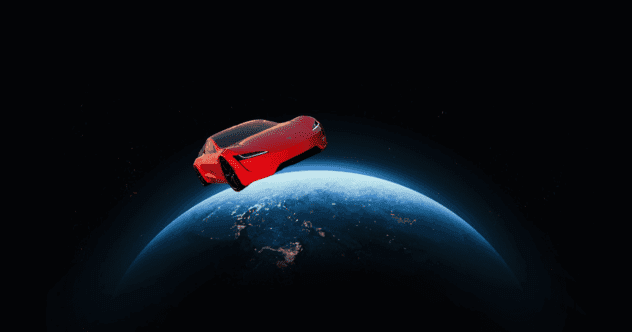Humanity’s quest to explore space has led to incredible achievements, but in between the serious science, there have been moments of pure whimsy. Believe it or not, some truly bizarre items have hitched a ride into the great unknown, each carrying its own unique and often amusing story.
These unusual space travelers reflect humanity’s playful spirit and inventive nature. Get ready for a countdown of the top 10 oddest objects that have made their way into the cosmos!
10. Salmonella Bacteria
Believe it or not, Salmonella bacteria, notorious for causing food poisoning, were sent to the International Space Station (ISS) on space shuttle missions in 2006 and 2008. The surprising result? These bacteria became more virulent in the microgravity environment of space than their Earth-bound counterparts.
This discovery has huge implications. The conditions in space mimic those inside human intestines, where a mechanical force called fluid shear is low. This similarity helps researchers understand how salmonella behaves inside the human body and opens doors for improving food safety, developing treatments, and creating vaccines to combat food poisoning, both on Earth and in space.
With NASA planning longer missions to the moon and Mars, understanding and combating microbial threats in space is crucial for astronaut health. Altering the levels of ions around the bacteria could even prevent the increase in virulence observed in space, offering new ways to treat salmonella infections.
9. Human Brainwaves
In 1977, as part of the Voyager Interstellar Mission, NASA sent two spacecraft into the cosmos, each carrying a golden record designed to last a billion years. These records contained sounds and music from Earth, including greetings in 59 languages and sounds of a mother’s first words and a kiss.
Led by Carl Sagan, the project aimed to communicate with any alien civilization that might encounter the records. Ann Druyan, Sagan’s future wife, contributed the electrical impulses of her brain and nervous system, recorded while meditating on love shortly after their engagement. This personal touch was intended to convey human emotion to extraterrestrial discoverers.
These golden records, carrying the sounds of Earth and the story of a human love, are now traveling at 35,000 miles per hour into interstellar space.
8. LEGO Figures
In 2011, NASA’s Juno spacecraft carried three special LEGO figurines to Jupiter: the Roman god Jupiter, his wife Juno, and Galileo Galilei. This was part of the “Bricks in Space” project, a collaboration between NASA and the LEGO Group aimed at inspiring kids in science, technology, engineering, and mathematics.
The spacecraft reached Jupiter in July 2016, where it orbited the planet. The LEGO figures, made of space-grade aluminum, represented mythological and scientific elements: Juno with a magnifying glass symbolizing her quest for truth, Jupiter with a lightning bolt, and Galileo with a telescope.
Alongside these figures, a plaque honoring Galileo, made of flight-grade aluminum, was also attached to Juno. It showcased a self-portrait of Galileo and included a passage he had written in 1610 about his observations of Jupiter.
7. Sea Urchin Sperm
In the 1990s, scientists launched sea urchin eggs into space on rockets to study if fertilization could occur in zero gravity, much like on Earth. They discovered that these eggs could indeed be fertilized and begin developing into baby sea urchins in space.
However, if the eggs spent time in space without being fertilized, they couldn’t start the process once they returned to Earth. Researchers found that the cells could feel the lack of gravity but continued to grow correctly, suggesting they have a unique way to sense gravity linked to their growth cycle.
These experiments demonstrated that rockets could be used to study how life begins and grows, and that the lack of gravity doesn’t seem to bother the very start of life for sea urchins. Scientists are still exploring how prolonged exposure to no gravity might affect development.
6. A Piece of the Wright Brothers’ Airplane
Neil Armstrong, the first man to walk on the moon in July 1969, carried pieces of the Wright Flyer as a tribute to Orville and Wilbur Wright. These included fabric and propeller pieces from the aircraft that achieved the first powered flight in 1903.
As the 50th anniversary of Armstrong’s lunar landing approached, over 3,000 of his personal items were auctioned, including parts of the Wright Flyer. Armstrong, an Ohioan like the Wright brothers, had always admired them and studied their work extensively.
The Apollo 11 mission was compared to the Wright brothers’ flight, highlighting how both events transformed humanity’s relationship with the environment and the cosmos. The courage required for both endeavors, though different in nature, left an indelible mark on history.
5. Luke Skywalker’s Lightsaber
In October 2007, the space shuttle Discovery’s STS-120 mission carried Luke Skywalker’s original lightsaber prop from the 1977 film Star Wars. This event celebrated the movie franchise’s 30th anniversary.
Before its journey, the lightsaber was sent off in a special ceremony at Oakland International Airport, handed over to NASA officials by Chewbacca. After arriving in Houston, Texas, the lightsaber was greeted by Stormtroopers and R2-D2 and displayed at Space Center Houston before its spaceflight.
The lightsaber’s space journey was a symbolic nod to the cultural impact of Star Wars, blending science fiction with real-world space exploration. It was a unique piece of cargo alongside the crew and a new module for the International Space Station.
4. A Tesla Roadster
In February 2018, SpaceX launched a Tesla Roadster into space on the maiden flight of their Falcon Heavy rocket. This was a symbolic act meant to inspire humanity, according to Elon Musk.
The Tesla Roadster, with its mannequin driver “Starman,” has been traveling on an elliptical orbit around the Sun. The roadster has already made its first close approach to Mars, coming within 5 million miles of the planet, and is on a trajectory that will also bring it close to Earth.
Orbiting for over two years, the car has metaphorically “driven” far beyond its original warranty. Eventually, it’s expected to either burn up in the atmosphere of Earth or Venus, but not for at least another 10 million years.
3. A Wheel of Cheese
In 2010, SpaceX launched a large wheel of Le Brouere cheese into orbit as a secret payload during the first flight of its Dragon space capsule. This whimsical act was a nod to a classic skit from Monty Python’s Flying Circus.
The cheese was encased in a metal cylinder, adorned with an image reminiscent of the Top Secret! film poster. SpaceX’s Dragon capsule became the world’s first commercial spacecraft to reach orbit and return to Earth safely.
This quirky event demonstrated SpaceX’s innovative approach and highlighted the company’s reusable rocket technology, marking a significant step toward more cost-effective space travel.
2. The Ashes of Star Trek’s Creator
In 2024, Celestis, a company that offers space burials, will launch a deep space mission carrying nearly 200 capsules of cremated remains and DNA samples, including those of Star Trek creator Gene Roddenberry and his wife, Majel Barrett Roddenberry.
The Voyager Memorial Spaceflight will send the remains on a journey to permanently orbit the Sun. The mission will also carry the remains of other Star Trek cast members, such as James Doohan (“Scotty”) and Nichelle Nichols (Lt. Uhura).
Launched from Cape Canaveral, Florida, the mission will propel the capsules past the Earth-Moon system to become part of the Enterprise Station, the most distant permanent human repository outpost orbiting the Sun. This marks a new chapter in space burials, allowing individuals to leave a lasting legacy in the cosmos.
1. A Corned Beef Sandwich
On March 23, 1965, during the Gemini 3 mission, astronaut John Young smuggled a corned beef sandwich into space. This mission was the first U.S. spaceflight to carry two astronauts, Young and Gus Grissom.
The presence of the sandwich was revealed during a brief exchange. Grissom decided to stow it away after it started crumbling, potentially endangering the spacecraft. The incident led to a review by the House of Representatives Committee on Appropriations, raising concerns about loose crumbs in space.
Despite the controversy, the sandwich incident is often remembered humorously. It even led to corned beef being officially included on the menu of the first space shuttle mission in 1981, which Young also commanded. Today, astronauts use tortillas to minimize crumbs, and a replica of the infamous sandwich is displayed at the Grissom Memorial Museum.
As our journey into space continues, who knows what other oddities might find their way into the cosmos? These bizarre items serve as a reminder of humanity’s boundless curiosity and playful spirit, even among the stars.
What do you think is the strangest thing ever sent to space? Leave your comment below!










